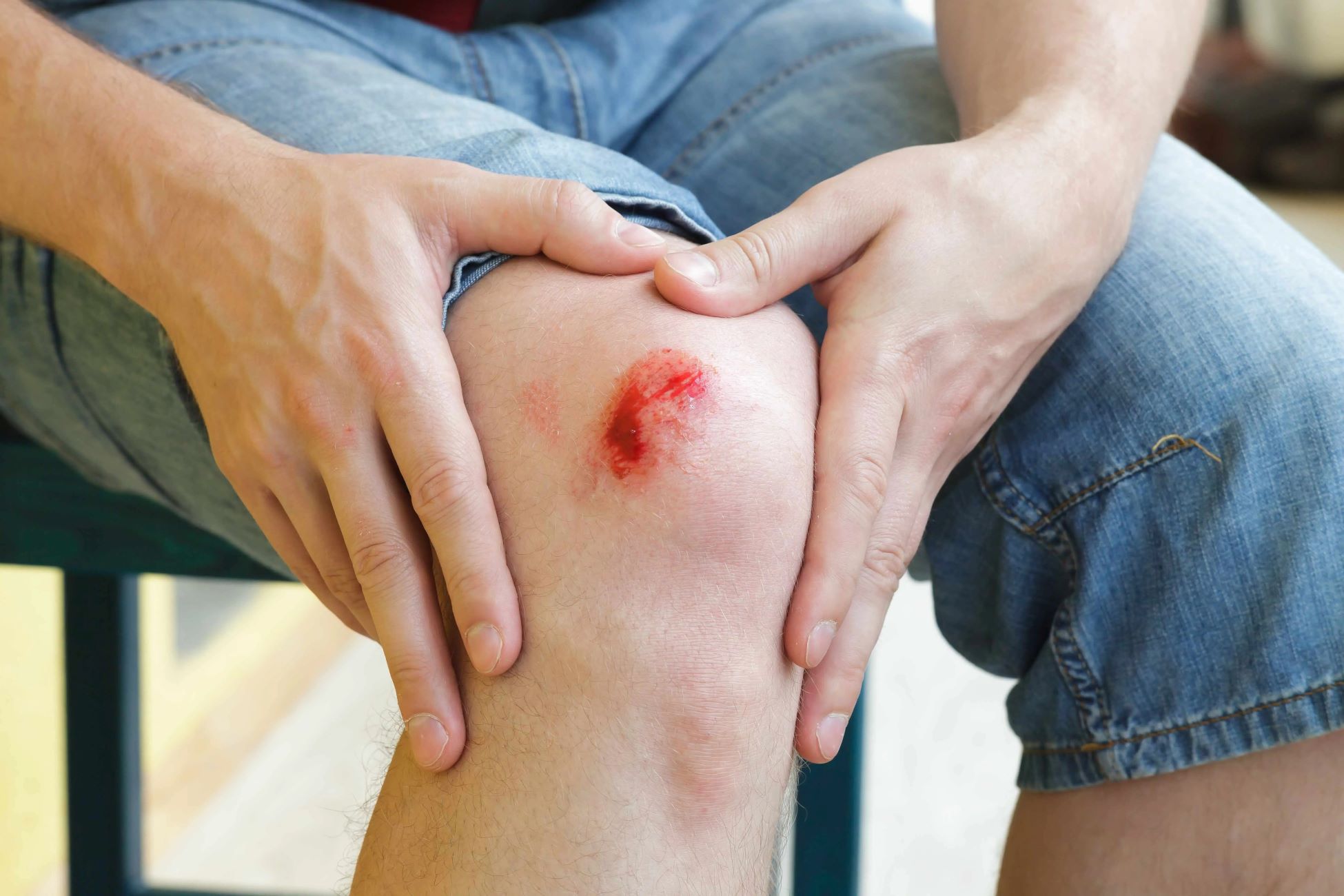Home>Health & Nutrition>Recovery>Healing Tips For Road Rash


Recovery
Healing Tips For Road Rash
Published: February 28, 2024
Discover effective recovery tips for road rash to promote healing and prevent scarring. Learn how to care for road rash injuries and speed up the recovery process.
(Many of the links in this article redirect to a specific reviewed product. Your purchase of these products through affiliate links helps to generate commission for Therunningadvisor.com, at no extra cost. Learn more)
Table of Contents
Understanding Road Rash
Road rash is a common injury that occurs when the skin makes direct contact with a rough surface, such as asphalt or concrete, during a fall or accident. This type of injury is frequently associated with activities like cycling, skateboarding, and motorcycling, where individuals are at risk of skidding or falling onto abrasive surfaces. The friction between the skin and the rough surface leads to the removal of the outer layers of skin, resulting in painful abrasions and potential exposure to contaminants.
When an individual experiences road rash, the affected area typically appears red, raw, and may exhibit bleeding. In more severe cases, the injury can involve deeper layers of tissue, leading to increased pain and a higher risk of infection. It's important to note that road rash injuries can vary in severity, from minor scrapes to more extensive wounds that require medical attention.
Understanding the nature of road rash is crucial for effectively managing and treating the injury. By recognizing the potential risks and implications of road rash, individuals can take proactive measures to address the injury and minimize the chances of complications. Whether it's assessing the extent of the abrasions or implementing appropriate wound care, a comprehensive understanding of road rash is essential for promoting optimal healing and recovery.
In the subsequent sections, we will delve into the essential steps for cleaning and disinfecting the wound, applying antibiotic ointment, dressing the wound, managing pain, preventing infection, and knowing when it's necessary to seek medical attention. These insights will empower individuals to navigate the process of road rash recovery with confidence and ensure that proper care is administered to promote healing and minimize potential complications.
Read more: Experience The Thrill Of Off-Road Duathlon
Cleaning and Disinfecting the Wound
Properly cleaning and disinfecting a road rash wound is a critical first step in the healing process. When the skin comes into contact with abrasive surfaces during a fall or accident, it is exposed to dirt, debris, and potentially harmful bacteria. Failing to thoroughly clean the wound can lead to infection and hinder the body's natural healing process. Therefore, it is essential to approach the cleaning and disinfection of road rash injuries with care and attention to detail.
To begin the cleaning process, it is important to gently rinse the affected area with mild soap and lukewarm water. This helps remove any visible dirt, debris, or foreign particles that may have become embedded in the wound. It is crucial to avoid using harsh or abrasive cleansers, as these can further irritate the injured skin and impede the healing process. Additionally, it is advisable to refrain from scrubbing the wound vigorously, as this can cause unnecessary pain and potential damage to the delicate skin.
After rinsing the wound, it is recommended to use a sterile saline solution to further cleanse the area. Saline solution is gentle on the skin and helps to flush out any remaining debris or contaminants. This step is particularly important for road rash injuries, as it aids in reducing the risk of infection and promotes a clean environment for the healing process to commence.
Once the wound has been thoroughly cleansed, it is crucial to pat the area dry with a clean, soft cloth or gauze. It is important to exercise caution and avoid rubbing the injured skin, as this can cause discomfort and potentially disrupt the delicate healing process. Ensuring that the area is completely dry is essential before proceeding to the next steps of wound care, such as applying antibiotic ointment and dressing the wound.
In summary, the process of cleaning and disinfecting a road rash wound involves gentle rinsing with mild soap and lukewarm water, followed by the use of sterile saline solution to further cleanse the area. It is imperative to handle the injured skin with care and avoid harsh cleansers or vigorous scrubbing. By adhering to these guidelines, individuals can effectively prepare the wound for subsequent treatment and promote a conducive environment for healing to take place.
Applying Antibiotic Ointment
After thoroughly cleaning and drying the road rash wound, the next crucial step in the healing process is the application of antibiotic ointment. This essential component of wound care serves multiple purposes in promoting healing and preventing infection.
Antibiotic ointments, such as bacitracin or neomycin, play a pivotal role in protecting the injured skin from harmful bacteria and other potential contaminants. By creating a barrier over the wound, these ointments help reduce the risk of infection, which is particularly important for road rash injuries due to the exposure of the raw skin to external elements.
When applying antibiotic ointment to a road rash wound, it is important to use a clean applicator, such as a sterile cotton swab or gauze, to avoid introducing additional bacteria to the area. A thin layer of the ointment should be gently and evenly spread over the entire affected area. It is crucial to refrain from using excessive amounts of the ointment, as this can impede the healing process and lead to unnecessary discomfort.
In addition to creating a protective barrier, antibiotic ointments also help keep the wound moist, which is conducive to the natural healing process. By maintaining a moist environment, the ointment supports the growth of new skin cells and facilitates the formation of a scab, which serves as a protective layer over the injured area.
Furthermore, the application of antibiotic ointment can help alleviate discomfort and pain associated with road rash injuries. The soothing properties of the ointment can provide relief to the affected individual, making the healing process more manageable and comfortable.
It is important to note that while antibiotic ointments are beneficial for preventing infection and promoting healing, individuals should be mindful of potential allergic reactions. If any signs of allergic response, such as redness, swelling, or increased pain, develop after applying the ointment, it is essential to discontinue use and seek medical advice.
In summary, the application of antibiotic ointment is a critical step in the management of road rash injuries. By creating a protective barrier, maintaining a moist environment, and potentially alleviating discomfort, antibiotic ointments play a pivotal role in promoting optimal healing and reducing the risk of infection. When administered with care and attention to detail, the application of antibiotic ointment sets the stage for the subsequent dressing of the wound and supports the body's natural healing processes.
Dressing the Wound
After cleaning the road rash wound and applying antibiotic ointment, the next crucial step is to dress the injury appropriately. Dressing the wound serves several essential functions in promoting healing, protecting the affected area, and minimizing the risk of infection.
The choice of dressing for a road rash wound is pivotal in creating an optimal environment for recovery. Non-adherent dressings, such as sterile gauze pads or silicone-based dressings, are commonly recommended for road rash injuries. These dressings are designed to gently cover the wound without sticking to the injured skin, minimizing discomfort and potential damage when the dressing is changed.
When applying the dressing, it is important to ensure that the entire affected area is adequately covered. The dressing should be secured in place with medical tape or a self-adherent wrap to prevent it from shifting or coming loose. However, it is crucial to avoid wrapping the dressing too tightly, as this can impede blood circulation and cause additional discomfort to the injured individual.
In addition to providing a protective barrier, the dressing plays a crucial role in maintaining a moist environment conducive to the healing process. By retaining moisture, the dressing supports the formation of new skin cells and facilitates the development of a scab, which shields the injured area from external elements and promotes the regeneration of healthy tissue.
Regularly changing the dressing is essential to ensure the cleanliness and integrity of the wound. It is recommended to change the dressing at least once a day, or more frequently if it becomes soiled or wet. During the dressing change, it is important to gently remove the existing dressing and assess the condition of the wound. Any signs of infection, such as increased redness, swelling, or discharge, should be promptly addressed by seeking medical attention.
Furthermore, individuals should monitor the healing progress of the road rash wound while keeping it dressed. Any unusual changes in the appearance or symptoms associated with the injury should be carefully noted, as they may indicate the need for medical evaluation.
In summary, dressing the road rash wound is a critical aspect of wound care that involves selecting the appropriate dressing, ensuring proper coverage, and maintaining a moist environment conducive to healing. By adhering to these guidelines and regularly changing the dressing, individuals can effectively support the body's natural healing processes and minimize the risk of complications associated with road rash injuries.
Pain Management
Effective pain management is a crucial aspect of road rash injury care, as individuals often experience varying degrees of discomfort and soreness following an accident or fall. The abrasions and raw skin associated with road rash injuries can cause significant pain, making it essential to implement strategies to alleviate discomfort and promote a more comfortable healing process.
One of the primary methods of pain management for road rash injuries is the use of over-the-counter pain relievers, such as acetaminophen or ibuprofen. These medications can help reduce pain and inflammation, providing individuals with relief from the discomfort associated with their injuries. It is important to follow the recommended dosage guidelines and consult a healthcare professional if there are any concerns about medication interactions or pre-existing medical conditions.
In addition to oral pain relievers, topical treatments, such as lidocaine or benzocaine-based creams or gels, can be applied directly to the affected area to provide localized pain relief. These topical treatments work by numbing the skin, thereby reducing the sensation of pain and discomfort. When using topical pain relievers, it is crucial to carefully follow the instructions for application and avoid using them on open wounds or broken skin.
Furthermore, implementing gentle wound care practices can contribute to pain management for road rash injuries. By keeping the wound clean, moisturized, and appropriately dressed, individuals can minimize the risk of additional discomfort and promote a more comfortable healing process. Ensuring that the dressing is secure but not overly tight can help alleviate unnecessary pressure on the injured skin, reducing discomfort and promoting a more favorable healing environment.
Engaging in activities that promote relaxation and stress reduction can also play a role in pain management for road rash injuries. Stress and anxiety can exacerbate the perception of pain, so incorporating relaxation techniques, such as deep breathing exercises, meditation, or gentle stretching, can help individuals manage their discomfort more effectively. Additionally, maintaining a positive mindset and seeking support from friends, family, or healthcare professionals can contribute to a more positive pain management experience.
By addressing pain management as an integral part of road rash injury care, individuals can navigate the healing process with greater comfort and resilience. Implementing a multifaceted approach that encompasses medication, topical treatments, gentle wound care, and stress reduction techniques can significantly alleviate discomfort and promote a more favorable healing environment for road rash injuries.
Preventing Infection
Preventing infection is a paramount consideration in the management of road rash injuries. The raw and exposed nature of the affected skin makes it particularly susceptible to bacterial infiltration, which can lead to complications and hinder the natural healing process. By implementing proactive measures to prevent infection, individuals can significantly reduce the risk of complications and promote optimal recovery.
One of the fundamental strategies for preventing infection in road rash wounds is maintaining a clean and sterile environment. This begins with thorough and gentle cleansing of the affected area, as previously discussed, to remove any dirt, debris, or foreign particles that could harbor harmful bacteria. Following the initial cleaning, it is essential to ensure that the wound remains protected from potential contaminants. This can be achieved by keeping the dressing clean, dry, and securely in place, thereby creating a barrier against external elements that could introduce bacteria to the injured skin.
Additionally, regular monitoring of the wound for any signs of infection is crucial for early detection and intervention. Any changes in the appearance of the wound, such as increased redness, swelling, or the presence of pus, should be promptly addressed by seeking medical attention. By remaining vigilant and proactive in observing the healing progress, individuals can identify potential signs of infection and take appropriate measures to mitigate the risk.
Furthermore, adhering to proper wound care practices, such as changing the dressing regularly and applying antibiotic ointment as recommended, plays a pivotal role in preventing infection. The dressing serves as a protective barrier, shielding the wound from external contaminants while maintaining a moist environment conducive to healing. By following the prescribed wound care regimen and ensuring that the injured skin is appropriately cared for, individuals can minimize the risk of infection and support the body's natural healing processes.
In addition to these measures, maintaining overall health and wellness can contribute to infection prevention. Adequate nutrition, hydration, and rest are essential for supporting the body's immune system, enabling it to combat potential threats of infection more effectively. By prioritizing overall well-being, individuals can bolster their body's defenses and enhance the healing capacity of road rash injuries.
In summary, preventing infection in road rash wounds involves maintaining a clean and sterile environment, regular monitoring for signs of infection, adhering to proper wound care practices, and prioritizing overall health and wellness. By integrating these proactive measures into the management of road rash injuries, individuals can minimize the risk of infection and create an optimal environment for healing and recovery.
When to Seek Medical Attention
Knowing when to seek medical attention for road rash injuries is crucial for ensuring proper care and addressing any potential complications that may arise. While many road rash wounds can be effectively managed at home with appropriate first aid and wound care, there are certain circumstances that warrant professional medical evaluation and treatment.
If the road rash injury is extensive, involving a large area of the body or exhibiting deep abrasions that penetrate beyond the outer layers of skin, it is advisable to seek medical attention promptly. Extensive road rash injuries may require specialized medical care to assess the extent of tissue damage, mitigate the risk of infection, and facilitate optimal healing.
Additionally, if the road rash wound shows signs of infection, such as increased redness, swelling, warmth, or the presence of pus, it is essential to consult a healthcare professional. Infections in road rash injuries can lead to complications and may necessitate the use of antibiotics or other medical interventions to address the underlying issue and promote healing.
Individuals with road rash injuries that are accompanied by severe pain, persistent bleeding, or signs of foreign objects embedded in the wound should seek medical attention for further evaluation and treatment. These symptoms may indicate underlying issues that require professional assessment to ensure proper wound care and management.
Furthermore, individuals who have underlying health conditions, such as diabetes or compromised immune systems, should consider seeking medical attention for road rash injuries, as these conditions can increase the risk of complications and necessitate specialized care to promote healing and prevent infection.
In cases where the road rash injury results from a high-impact or motor vehicle accident, it is advisable to seek medical evaluation, even if the initial assessment indicates minor abrasions. The force and nature of such accidents can result in hidden injuries or complications that may not be immediately apparent, making professional medical assessment essential for comprehensive care.
Ultimately, if there is any uncertainty or concern regarding the severity or management of a road rash injury, seeking medical attention is a prudent course of action. Healthcare professionals can provide expert evaluation, personalized treatment recommendations, and ongoing support to ensure the optimal healing and recovery of road rash injuries.
By recognizing the specific circumstances that warrant medical attention and promptly seeking professional evaluation when necessary, individuals can proactively address road rash injuries and access the appropriate care to promote healing and minimize potential complications.















